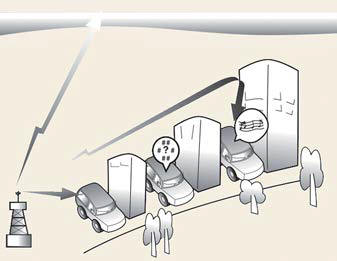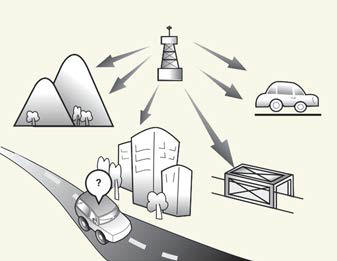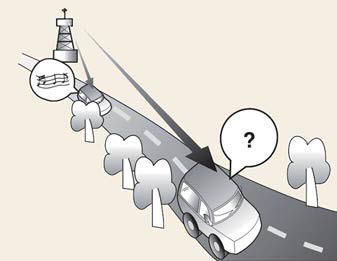Kia Sportage: Audio system
NOTICE
If you install an aftermarket HID headlamp, your vehicle's audio and electronic device may malfunction.
* If your vehicle is equipped with infotainment system, refer to a separately supplied manual for detailed information.
Sharkfin antenna

The sharkfin antenna transmits and receives wireless signals such as AM/FM, Sirius XM, GNSS, etc.
* The signals which antenna can transmit and receive vary by the vehicle option.
NOTICE
- Avoid adding metallic coatings such as Ni, Cd, etc. These can degrade the receiving AM and FM broadcast signals.
USB port
You can use the USB port to plug in an USB.

CAUTION
Depending on the size, length, or shape of the USB stick, if you forcibly close the tray cover, the USB device may be damaged, deformed or the cover may not reopen as the device is stuck.
When the stick is stuck, forcibly opening the cover can also cause damage to the device.
If the USB stick does not fit into the space, do not close the cover and try another USB stick with different specifications.
How vehicle radio works
FM reception

AM and FM radio signals are broadcast from transmitter towers located around your city. They are intercepted by the radio antenna on your vehicle. This signal is then processed by the radio and sent to your vehicle speakers.
However, in some cases the signal coming to your vehicle may not be strong and clear.
This can be due to factors, such as the distance from the radio station, closeness of other strong radio stations or the presence of buildings, bridges or other large obstructions in the area.
AM reception

AM broadcasts can be received at greater distances than FM broadcasts.
This is because AM radio waves are transmitted at low frequencies. These long distance, low frequency radio waves can follow the curvature of the earth rather than traveling straight. In addition, they curve around obstructions resulting in better signal coverage
FM radio station

FM broadcasts are transmitted at high frequencies and do not bend to follow the earth's surface. Because of this, FM broadcasts generally begin to fade within short distances from the station.
Also, FM signals are easily affected by buildings, mountains, and obstructions.
This can lead to undesirable or unpleasant listening conditions which might lead you to believe a problem exists with your radio.
The following conditions are normal and do not indicate radio trouble:
- Fading - As your vehicle moves away
from the radio station, the signal will
weaken and sound will begin to fade.
When this occurs, we suggest that you select another station with a stronger signal.

- Flutter/Static - Weak FM signals or large obstructions between the transmitter and your radio can disturb the signal causing static or fluttering noises to occur. Reducing the treble level may lessen this effect until the disturbance clears.
- Station Swapping - As an FM signal weakens, another more powerful signal near the same frequency may begin to play. This is because your radio is designed to lock onto the clearest signal. If this occurs, select another station with a stronger signal.

- Multi-Path Cancellation - Radio signals
being received from several
directions can cause distortion or fluttering.
This can be caused by a direct and reflected signal from the same station, or by signals from two stations with close frequencies. If this occurs, select another station until the condition has passed.
Using a cellular phone or a twoway radio
When a cellular phone is used inside the vehicle, noise may be produced from the audio system. This does not mean that something is wrong with the audio equipment. In such a case, try to operate mobile devices as far from the audio equipment as possible.
When using a communication system such as a cellular phone or a radio set inside the vehicle, a separate external antenna must be fitted. When a cellular phone or a radio set is used with only the internal antenna, it may interfere with the vehicle's electrical system and adversely affect the safe operation of the vehicle.
WARNING
Cell phone use
Do not use a cellular phone while driving.
Stop at a safe location to use a cellular phone.
WARNING
Distracted driving
Driving while distracted can result in a loss of vehicle control that may lead to an accident, severe bodily injury, or death. The driver's primary responsibility is in the safe and legal operation of a vehicle. Any use of handheld devices, other equipment, or vehicle systems that take the driver's eyes, attention, and focus away from the safe operation of a vehicle are not permissable by law.
These should never be used during the operation of the vehicle.
READ NEXT:
 Declaration of Conformity
Declaration of Conformity
FCC
This equipment has been tested and
found to comply with the limits for a
Class B digital device, pursuant to part
15 of the FCC Rules. These limits are
designed to provide reasonable protecti
 Driving your vehicle
Driving your vehicle
Be sure the exhaust system does not leak
The exhaust system should be checked
whenever the vehicle is raised to change
the oil or for any other purpose.
If you hear a change in the sound of the
 Before driving
Before driving
Before getting into the vehicle, you
should examine the vehicle and its surroundings.
After getting into the vehicle,
you should check a number of things
before driving.
Before entering vehicle
SEE MORE:
 Spot welding
Spot welding
1. Commercial spot welding machines do not perform
as well as the machines used in the manufacturing
process. When spot welding, increase the number
of spot welds by 30% (1.3 times the original number
of welds).
2. When spot welding, weld in the middle of the joint.
Spot welding on the
 Engine And Transaxle Assembly
Engine And Transaxle Assembly
Engine Mounting
Components and
Components Location
Components
Transaxle mounting bracket
Roll rod bracket
Sub frame
Engine mounting bracket
Engine mounting support
bracket
Engine And Transaxle Assembly
Repair procedures
Removal
CAUTION
Use fender covers to avoid da
Content
- Home
- Kia Sportage - Fifth generation (NQ5) - (2022-2025) - Owner's Manual
- Kia Sportage - Second generation (JEKM) (2005-2015) - Body Workshop Manual
- Kia Sportage Third generation (SL) - (2011-2016) - Service and Repair Manual
- Sitemap
- Top articles